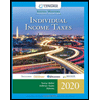
Calculate Tax Liability. What would be the tax liability for a single taxpayer who has a gross income of $50,050? (Hint: Use Table 4-3, and don’t forget to subtract the value of a standard deduction and one exemption.)
To calculate: Tax liability for a single taxpayer.
Introduction: Tax is payable on net taxable income. The income is taxed on the basis of slabs. Tax is calculated for each slab of the income separately. The tax slabs are determined by the government and these slabs keep changing from year to year.
Answer to Problem 1DTM
Tax liability for a single tax payer is $5696.25
Explanation of Solution
Tax liability for a single tax payer is calculated as follows:
Standard deduction of $6,300 and personal exemption of $4050, total $10,350 is not taxed. The tax on additional income 50,050 less 10350 = $39700 is calculated as follows:
| Single individual if taxable income is | Rate | Amount | Tax |
| A | B | = A*B | |
| up to $9275 | 10% | $ 9,275 | $ 927.50 |
| over $9275 and up to $37650 | 15% | $ 28,375 | $ 4,256.25 |
| over $37650 and up to $91150 | 25% | $ 2,050 | $ 512.50 |
| Total | $ 39,700 | $ 5,696.25 |
Want to see more full solutions like this?
Chapter 4 Solutions
Personal Finance (MindTap Course List)
- Principles of Accounting Volume 1AccountingISBN:9781947172685Author:OpenStaxPublisher:OpenStax College
 Individual Income TaxesAccountingISBN:9780357109731Author:HoffmanPublisher:CENGAGE LEARNING - CONSIGNMENT
Individual Income TaxesAccountingISBN:9780357109731Author:HoffmanPublisher:CENGAGE LEARNING - CONSIGNMENT





